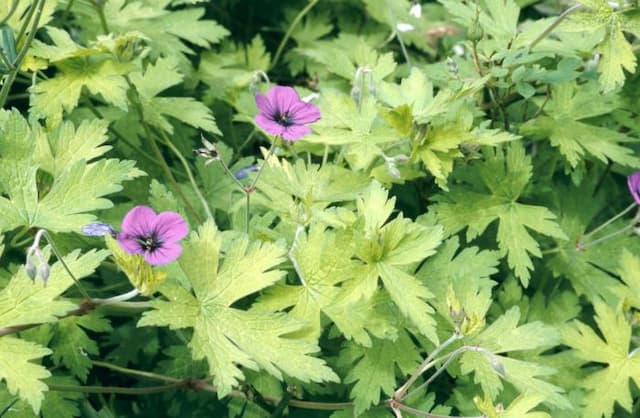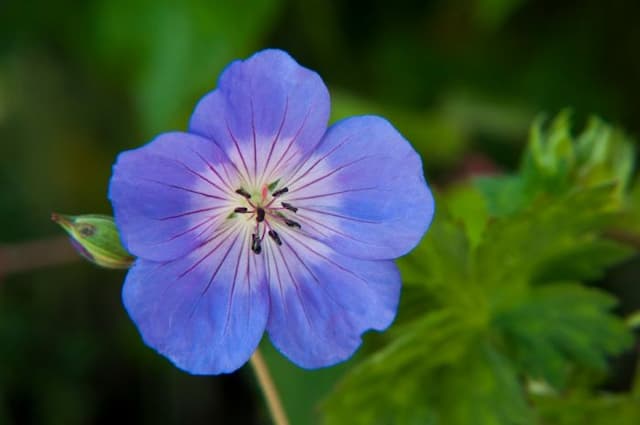Bigroot Geranium Geranium macrorrhizum 'Czakor'

ABOUT
Geranium macrorrhizum 'Czakor', commonly known as the Bigroot Geranium or Rock Cranesbill, is an attractive, mat-forming perennial plant. This variety is known for its dense, fragrant, lobed foliage that often displays attractive shades of green with a hint of reddish-bronze, particularly as the cooler weather sets in. The leaves are typically rounded, deeply cut into five to seven lobes, and bear a soft texture. The Bigroot Geranium 'Czakor' showcases charming flowers, which bloom in profusion from late spring to early summer. The flowers rise slightly above the foliage and exhibit a rounded shape. They are usually a vibrant, magenta-pink color with petals that are veined and rounded, giving them a quaint and delicate appearance. Each flowering stalk may hold several blossoms. Additionally, the plant is valued for its aromatic qualities. When the leaves are brushed or crushed, they release a strong, pleasant fragrance. This scent is one of the reasons the Bigroot Geranium is often used in gardens, not only for its beauty but also for the sensory experience it provides. Beyond its visual and olfactory appeal, this variety is known for being hardy and adaptable, often used as ground cover due to its spreading habit. Its robust nature and attractive features make it a popular choice for gardeners looking to add reliable and low-maintenance beauty to their garden landscapes.
About this plant
 Names
NamesFamily
Geraniaceae.
Synonyms
Bigroot Geranium, Rock Crane's-bill, Bulgarian Geranium.
Common names
Geranium macrorrhizum 'Czakor'.
 Toxicity
ToxicityTo humans
Geranium macrorrhizum 'Czakor', commonly known as Bigroot Geranium, is not known to be toxic to humans. There are no significant symptoms of poisoning associated with this plant, as it is not considered harmful if accidentally ingested. However, it is always advisable to avoid eating any plant parts unless they are known to be safe for consumption.
To pets
Bigroot Geranium is not considered to be toxic to pets either. It is not known to cause any significant symptoms of poisoning in animals if they ingest parts of the plant. As with humans, it is generally recommended to prevent pets from eating plants that are not intended for consumption to avoid any potential gastrointestinal upset.
 Characteristics
CharacteristicsLife cycle
Perennials
Foliage type
Semi-deciduous
Color of leaves
Green
Flower color
Pink
Height
12-18 inches (30-45 cm)
Spread
18-24 inches (45-60 cm)
Plant type
Herb
Hardiness zones
4
Native area
Southeastern Europe
Benefits
 General Benefits
General Benefits- Ornamental appeal: Geranium macrorrhizum 'Czakor', commonly known as bigroot geranium, has attractive foliage and magenta-pink flowers that add color and texture to gardens.
- Low maintenance: This plant is known for being easy to grow and requiring minimal care once established, making it ideal for gardeners of all skill levels.
- Drought tolerant: Once established, bigroot geraniums are quite drought-resistant, conserving water and surviving in drier conditions.
- Ground cover: The bigroot geranium is effective at covering bare spots in the landscape and suppressing weeds with its dense foliage.
- Rapid growth: It quickly fills in garden spaces, which can be beneficial for creating lush landscapes in a short period of time.
- Pest resistance: These plants are resistant to many pests, reducing the need for chemical pesticides and contributing to a healthier garden ecosystem.
- Deer and rabbit resistance: The foliage is unappealing to deer and rabbits, making it a good choice for areas where these animals are a problem.
- Soil erosion control: Bigroot geranium's robust root system helps to stabilize soil and prevent erosion, particularly on slopes or in areas with loose soil.
- Seasonal interest: Its foliage often turns an attractive reddish hue in the fall, providing seasonal interest beyond its flowering period.
- Fragrant foliage: The leaves of Geranium macrorrhizum 'Czakor' are aromatic, which can add a pleasant scent to the garden and deter some pests.
 Medical Properties
Medical PropertiesThis plant is not used for medical purposes.
 Air-purifying Qualities
Air-purifying QualitiesThis plant is not specifically known for air purifying qualities.
 Other Uses
Other Uses- Geranium macrorrhizum 'Czakor', commonly known as cranesbill, can be used as a natural insect repellent due to its aromatic foliage, which is unappealing to many pests.
- The dried leaves of cranesbill can be used in potpourri to give a pleasant fragrance to a room, as the leaves retain their scent even when dried.
- When planted along walkways or paths, cranesbill acts as an effective ground cover that can endure foot traffic while providing a lush, dense mat of foliage and flowers.
- Its dense growing habit makes cranesbill an ideal plant for stabilizing soil on slopes and banks, preventing erosion and runoff.
- Gardeners sometimes use cranesbill as a living mulch between vegetable rows, where it suppresses weeds and keeps the soil moist and cool.
- Cranesbill’s nectar-rich flowers attract beneficial pollinators, such as bees and butterflies, helping to maintain a healthy, biodiverse garden ecosystem.
- The plant can be incorporated into sensory gardens where its textured leaves and aromatic nature can be appreciated by visitors seeking a tactile experience.
- Flower presses often include the vibrant blooms of cranesbill, which retain their color well, adding a splash of pink to artisan crafts and decorations.
- The plant can serve as a seasonal gauge for gardeners, as its growth and bloom times can indicate optimal planting periods for other garden species.
- When used in creative landscaping, cranesbill can create varying levels of visual interest, with its mounding habit providing a mid-height layer beneath taller shrubs and trees.
Interesting Facts
 Feng Shui
Feng ShuiThe Bigroot Geranium is not used in Feng Shui practice.
 Zodiac Sign Compitability
Zodiac Sign CompitabilityThe Bigroot Geranium is not used in astrology practice.
 Plant Symbolism
Plant Symbolism- Unity - Geraniums are often associated with coming together and harmony, making them a symbol for unity in friendship and relationships.
- Health - They are known to have medicinal properties, representing health and healing.
- Protection - With their strong scent and traditional use in warding off evil spirits, geraniums can symbolize protection.
- Fertility - Some cultures see geraniums as a symbol of fertility, possibly due to their prolific blooming and ease of propagation.
- Good Fortune - The abundance of flowers can represent prosperity and good luck.
 Water
WaterBigroot geraniums, like the Geranium macrorrhizum 'Czakor', prefer consistent moisture but also need well-draining soil to prevent root rot. During the growing season, water them deeply once a week, providing about one to two gallons of water for each plant, depending on the weather conditions. In hot, dry periods, you may need to water more frequently to maintain soil moisture. Always check the top inch of soil for dryness before watering again. Reduce watering in the winter when the plant is dormant, as overwatering can lead to fungal diseases.
 Light
LightThe best light conditions for bigroot geraniums, such as Geranium macrorrhizum 'Czakor', include partial shade to full sun. They perform well in a spot that receives morning sunlight and is shaded during the hottest part of the day. However, they can also tolerate full sun if they have enough moisture. Avoid deep shade, as this can result in poor flowering and leggy growth.
 Temperature
TemperatureBigroot geraniums like Geranium macrorrhizum 'Czakor' thrive in a broad range of temperatures, doing well in the garden from spring to fall. They can survive winter temperatures down to about 20°F, though they prefer the growing season to be between 60°F and 75°F. They are quite frost tolerant and can often handle temperatures a few degrees lower than their minimum threshold temporarily without significant damage.
 Pruning
PruningPruning bigroot geraniums, particularly Geranium macrorrhizum 'Czakor', is essential for maintaining plant health and encouraging dense growth. Remove dead or yellowing leaves throughout the growing season to improve plant appearance and prevent disease. After flowering, cut back the plants by about one-third to rejuvenate the foliage and potentially promote a second flush of blooms. The best time to perform this heavier pruning is in late summer or early fall.
 Cleaning
CleaningAs needed
 Soil
SoilThe best soil mix for Bigroot Geranium is well-draining garden soil with added organic matter like compost or aged manure. It thrives in a pH range of 5.8 to 6.3.
 Repotting
RepottingBigroot Geranium typically does not require frequent repotting and can be repotted every 3 to 4 years or as needed when it outgrows its pot.
 Humidity & Misting
Humidity & MistingBigroot Geranium tolerates a wide range of humidity levels and does well in average household humidity conditions.
 Suitable locations
Suitable locationsIndoor
Place in bright, indirect light; ensure pot has good drainage.
Outdoor
Plant in partial shade to full sun; mulch and water regularly.
Hardiness zone
3-8 USDA
 Life cycle
Life cycleThe life of Geranium macrorrhizum 'Czakor', or bigroot geranium, starts from seed, where it undergoes germination in moist, well-draining soil typically in spring or early summer. Upon sprouting, the seedling grows into a young plant with characteristic lobed leaves, developing a deep root system that allows it to survive drought conditions. It enters a vegetative stage where it grows rapidly, reaching maturity in a couple of seasons, and forms a dense, ground-covering foliage, with the stems becoming woody at the base. This perennial herbaceous plant then enters a flowering phase in late spring to early summer, producing clusters of small, magenta or pink flowers attractive to pollinators. After pollination, it sets seed that can disperse to propagate new plants, although the bigroot geranium often spreads more readily by rhizomes. The plant enters a period of dormancy in winter, where the above-ground foliage may die back but the root system remains alive, ready to regrow in the following spring.
 Propogation
PropogationPropogation time
Spring to early summer
Geranium macrorrhizum 'Czakor', commonly known as the Bigroot Geranium, is most effectively propagated by division. The best time for this method is in the spring or early fall when the plant is not in full bloom. To propagate by division, carefully dig up the plant with a shovel, taking care to keep the root ball intact. Then, using your hands or a sharp knife, split the plant into smaller sections, ensuring each section has a good amount of roots and a few shoots. Replant the divisions promptly into prepared soil, spacing them about 12 to 15 inches (about 30 to 38 centimeters) apart to allow for adequate growth. Water the new plants thoroughly to settle the soil around the roots and remove any air gaps. Division is a simple and efficient way to increase your Bigroot Geranium population while also rejuvenating older plants that may have become woody or overgrown.









